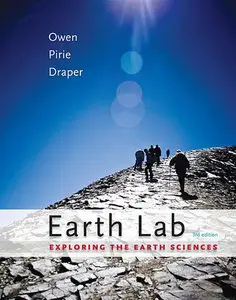"Earth Lab: Exploring the Earth Sciences" by Claudia Owen, Diane Pirie, Grenville Draper
Third Edition
Cengage Learning, Brooks/Cole | 2011 | ISBN: 053873700X 9780538737005 | 474 pages | PDF | 76 MB
Third Edition
Cengage Learning, Brooks/Cole | 2011 | ISBN: 053873700X 9780538737005 | 474 pages | PDF | 76 MB
Utilizing graphs and simple calculations, this clearly written lab manual complements the study of earth science or physical geology. You'll learn how to understand aerial and satellite images; to perceive the importance of stratigraphic columns, geologic sections, and seismic waves; and more.
Engaging activities are designed to help you develop data-gathering skills (e.g., mineral and rock identification) and data-analysis skills.
Contents
LAB 1 Introduction to Plates and Maps
Introduction to Plates and the Theory of Plate Tectonics
Rock Cycle
Types of Maps
Map Legend
Scale
Referring to Locations on a Map
LAB 2 Minerals
Definition of a Mineral
Properties
Mineral Identification
Classification of Minerals
Silicate Minerals
Economically Valuable and Useful Minerals
LAB 3 Igneous Rocks
Mineralogical and Chemical Composition of Igneous Rocks
Igneous Textures Reveal How Igneous Rocks Form
Classification and Identification of Igneous Rocks
Igneous Rock Masses
Hydrothermal Veins
LAB 4 Sedimentary Rocks
Formation of Sedimentary Rocks
Clastic Sedimentary Rocks
Biochemical and Chemical Sedimentary Rocks
Sedimentary Environments
Identification and Description of Sedimentary Rocks
LAB 5 Metamorphic Rocks
Metamorphic Processes and Types of Metamorphism
Classifying and Naming Metamorphic Rocks
Common Minerals of Metamorphic Rocks
Textures of Metamorphic Rocks
Temperature and Pressure of Metamorphism
Identification and Description of Metamorphic Rocks
Metamorphic Zones Mapping Exercise
LAB 6 Topographic Maps
Topography and Contours
Constructing Topographic Maps and Profiles
Using Topographic Maps
Aerial Photos Give a View of the Third Dimension
LAB 7 Geologic Time and Geologic History
Relative Age
Geologic History
Absolute Dating Techniques
Geologic Time Scale
LAB 8 Geologic Maps and Structures
Introduction to Geologic Maps and Cross Sections
Structures and Deformation
Contacts on Geologic Maps
Interpreting Geologic History from Geologic Maps and Cross Sections
Drawing a Cross Section
Making Geologic Maps from Field Investigations
Mapmaking Simulation
LAB 9 Plate Tectonics
Plate Boundaries
Wandering Continents
LAB 10 Earthquakes and Seismology
Earthquake Hazards
The Origin of Earthquakes
Magnitude
Locating an Earthquake
LAB 11 Landslides and Mass Movements
Mass Wasting Is Hazardous
Factors Influencing Mass Wasting
Types of Mass Wasting
LAB 12 Streams and Rivers
Stream Gradient and Sinuosity
Stream Erosion and Its Stages
Flooding
LAB 13 Groundwater and Karst Topography
Porosity
Permeability and Flow Rate
Water Table, Groundwater Flow, and Wells
Groundwater Depletion
Groundwater Contamination
Groundwater Causes Erosion by Solution
LAB 14 Shorelines and Oceans
The Edge of the Oceans
Shorelines
Ocean Currents
Ocean Salinity and Deep Ocean Currents
LAB 15 Atmosphere and Climate
The Earth-Sun Relationship
Wind and Coriolis Effect
Past Climate Fluctuations
Earth's Energy Budget and the Greenhouse Effect
Radiative Forcing and Anthropogenic Warming
Ozone Layer
LAB 16 Weather
Conditions of the Air
El Nino—La Nina
LAB 17 Glaciers and Glaciation
Glacier Types and Their Movement
Landforms Resulting from Glaciation
Climate Change and Glaciers
LAB 18 Deserts and Arid Landscapes
Types of Deserts
Wind Transport and Erosion
Depositional Desert Landforms
Combined Landscapes
Desertification
APPENDIX
Scientific Methods
Special Features of the Earth Sciences
Apply the Scientific Method to Your Own Life
GLOSSARY
with TOC BookMarkLinks



